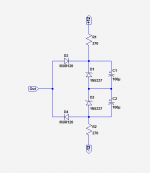I have been working on a headphone amplifier for a while now where the basic idea is to have a DC coupled output. My issue however is safety. Usually OTL amplifiers use an output capacitor to eliminate DC output, this issue I have solved with a DC-servo.
What happens when a tube shortcircuits. In such a incident i expect the output to reach the output DC-link of 60V on the out to my headphones. This of course is not something I would like to happen.
My idea is to add relay that is triggered by overvoltage on the output which will disconnect both input and output to the amplifier. Unfortunately the relay has a reaction time of 3ms, so I need something to keep the output voltage down until the relay cuts off.
The output voltage is monitored by a LM319 80ns comparator and latched with a 100ns gate. So my fault detection time is about 200-300ns or in other words it has a frequency response of 3-5MHz.
My suggestion would be a big TVS diode or a TRIAC triggered by the fault detection. The TVS however does seem to suffer from large parasitic capacitance which will limit the amplifier bandwidth.
As you can see I am looking for a way to eliminate high voltage spikes, so an output capacitor will not provide any safety in this case.
So what methods can I use to clamp the output voltage to a safe level in the 3ms it takes the relay to release?
What happens when a tube shortcircuits. In such a incident i expect the output to reach the output DC-link of 60V on the out to my headphones. This of course is not something I would like to happen.
My idea is to add relay that is triggered by overvoltage on the output which will disconnect both input and output to the amplifier. Unfortunately the relay has a reaction time of 3ms, so I need something to keep the output voltage down until the relay cuts off.
The output voltage is monitored by a LM319 80ns comparator and latched with a 100ns gate. So my fault detection time is about 200-300ns or in other words it has a frequency response of 3-5MHz.
My suggestion would be a big TVS diode or a TRIAC triggered by the fault detection. The TVS however does seem to suffer from large parasitic capacitance which will limit the amplifier bandwidth.
As you can see I am looking for a way to eliminate high voltage spikes, so an output capacitor will not provide any safety in this case.
So what methods can I use to clamp the output voltage to a safe level in the 3ms it takes the relay to release?
Fail safe circuits can fail.
Even the 'safe' output coupling capacitor can short.
Oh, and depending on how the amplifier powers up, there can be lots of voltage to the earphones until the amp stabilizes/warms up (charges the output capacitor).
A low DCR choke across the output prevents DC, but can have a transient during warm-up and stabilization.
Pick your method and live with it.
Or use an output transformer, that becomes a totally different amplifier.
All methods have tradeoffs.
Even the 'safe' output coupling capacitor can short.
Oh, and depending on how the amplifier powers up, there can be lots of voltage to the earphones until the amp stabilizes/warms up (charges the output capacitor).
A low DCR choke across the output prevents DC, but can have a transient during warm-up and stabilization.
Pick your method and live with it.
Or use an output transformer, that becomes a totally different amplifier.
All methods have tradeoffs.
Last edited:
- Status
- This old topic is closed. If you want to reopen this topic, contact a moderator using the "Report Post" button.
